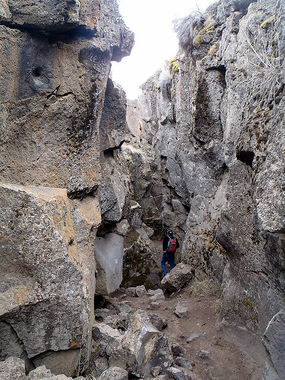Crack In the Ground
| Rating: | |||||||||||||||||||||||||||||||
|---|---|---|---|---|---|---|---|---|---|---|---|---|---|---|---|---|---|---|---|---|---|---|---|---|---|---|---|---|---|---|---|
| | Difficulty:2A II (v1a1 II) Raps:
Red Tape:No permit required Shuttle:None Vehicle:Passenger | ||||||||||||||||||||||||||||||
| Location: | |||||||||||||||||||||||||||||||
| Condition Reports: | 27 Oct 2019
"Fun! Not really a must-see destination in its own right, but an interesting stop if youre in the area and have a few hours to kill. Theres a good |
||||||||||||||||||||||||||||||
| Best season: | Jan-Dec
|
||||||||||||||||||||||||||||||
| Regions: | |||||||||||||||||||||||||||||||
Introduction[edit]
A two-mile long fault-crack located outside Christmas Valley, OR. While not a water-eroded canyon, there's enough narrows, slots and scrambling to keep you busy. The bottom of the crack widens and narrows, rises and falls. Expect a lot of up and down, with walls rising on either side from 10 to 70ft in places. You'll find yourself climbing up or down giant piles of boulders. In several places giant blocks of rock create natural bridges spanning the chasm. The shaded depths can hold snow late into summer.
Bring a helmet as there are some narrow spaces to squeeze through and plenty of places to bump your head. Rope, harness & other gear not required, although this would be a good place for training.
Doing a full exploration from north to south will take 3-4 hours, although the Crack can be exited in many places to make the trip as long or short as you like. This area may be busy on summer weekends.
Directions[edit]
From Christmas Valley, take Crack in the Ground Rd north 7.5mi to the main parking area for Crack in the Ground.
Approach[edit]
From the main parking area, hike in around 0.3mi to a picnic table in a wide open flat area. This is the dividing point between the north and middle sections of the Crack.
Descent[edit]
Follow along the crack north or south as far as you like. Some sections are easy hiking with an obvious trail. Other parts will require negotiating your way over, around, and through a maze of giant boulders. You may need to worm your way through some small spaces and talus caves. In a few places there are lateral side cracks to explore - or parallel ones along the way. There are numerous rock formations. If the scrambling gets too tough, you can always turn around and go back. Every so often, openings on the side permit exit. Be ready for a lot of up and down.
There is another section of chasm about 0.3mi south of the middle section. It's an easy walk, but visited less frequently.
Exit[edit]
From any point along the Crack you can bushwhack west / northwest to the road, or follow trails along one side of the Crack or the other back the way you came.
Red tape[edit]
None.
Beta sites[edit]
 CanyoneeringNorthwest.com (archive.org) : Crack in the Ground
CanyoneeringNorthwest.com (archive.org) : Crack in the Ground Super Amazing Map : Crack in the Ground
Super Amazing Map : Crack in the Ground SummitPost.org : Crack in the Ground
SummitPost.org : Crack in the Ground
